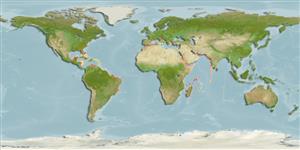Zoothamnium niveum Ehrenberg, 1838
| Native range | All suitable habitat | Point map | Year 2050 |

|
| This map was computer-generated and has not yet been reviewed. |
| Zoothamnium niveum AquaMaps Data sources: GBIF OBIS |
Upload your photos
Google image |
No photo available for this species.No drawings available for Zoothamniidae.
Google image |
No photo available for this species.
Classification / Names Common names | Synonyms | CoL | ITIS | WoRMS
Oligohymenophorea | Sessilida | Zoothamniidae
Environment: milieu / climate zone / depth range / distribution range Ecology
Benthic; brackish. Tropical
Distribution Countries | FAO areas | Ecosystems | Occurrences | Introductions
Western Central Atlantic.
Length at first maturity / Size / Weight / Age
Maturity: Lm ? range ? - ? cm Max length : 1.5 cm TL male/unsexed; (Ref. 87022); common length : 0.5 cm TL male/unsexed; (Ref. 87023)
Average length is 0.3 to 0.5 cm (Ref. 87023). The surface of this species is known to be a favorable habitat for sulfide-oxidizing bacteria (Ref. 87023). It inhabits mangrove peat walls in groups of more than 100 colonies, with an estimated group life of approximately 20 days, mainly in areas where microbial surface mat has been destroyed (Ref. 87022). It is found attached to a substrate, particularly in subtidal areas where sulfide sources are present. Large colonies are observed on garbage bags and rotting vegetables found in mangrove ponds. Generally is occupies ephemeral habitats where it is patchily distributed (Ref. 85814). The peritrich ciliate is a filter feeder, and its microzooids possess a fully developed oral ciliature and cytopharynx (Ref. 87023).
Life cycle and mating behavior Maturity | Reproduction | Spawning | Eggs | Fecundity | Larvae
Members of the phylum Ciliophora reproduce either through conjugation wherein exchange of genes occur or by budding.
Main reference
References | Coordinator | Collaborators
Rinke, C., S. Schmitz-Esser, K. Stoecker, A.D. Nussbaumer, D.A. Molna´r, K. Vanura, M. Wagner, M. Horn, J.A. Ott and M. Bright. 2006. (Ref. 87022)
IUCN Red List Status
(Ref. 130435: Version 2024-2)
CITES status (Ref. 108899)
Not Evaluated
CMS (Ref. 116361)
Not Evaluated
Threat to humans
Harmless
Human uses
| FishSource |
Tools
More information
Trophic Ecology
Food items
Diet composition
Food consumption
Food rations
Predators
Diet composition
Food consumption
Food rations
Predators
Ecology
Population dynamics
Growth
Max. ages / sizes
Length-weight rel.
Length-length rel.
Length-frequencies
Mass conversion
Recruitment
Abundance
Max. ages / sizes
Length-weight rel.
Length-length rel.
Length-frequencies
Mass conversion
Recruitment
Abundance
Life cycle
Distribution
Human Related
Aquaculture profiles
Stamps, coins, misc.
Stamps, coins, misc.
Outreach
References
Internet sources
BHL | BOLD Systems | CISTI | DiscoverLife | FAO(Publication : search) | Fishipedia | GenBank (genome, nucleotide) | GloBI | Gomexsi | Google Books | Google Scholar | Google | PubMed | Tree of Life | Wikipedia (Go, Search) | Zoological Record


